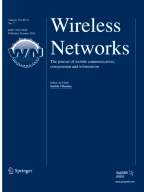Abstract
In this paper, we present a model that estimates the time duration of routes formed by several intermediate nodes in mobile multi-hop ad-hoc networks. First, we analyze a 3-node route, where only the intermediate node is in movement while source and destination nodes remain static. From this case, we show how route duration is affected by the initial position of the intermediate node and the size of the region where it is located. We also consider a second case where all nodes of 3-node routes are mobile. Based on extensive analysis of these routes, we determine the PDF of route duration under two different mobility models. This PDF can be determined by either analytical or statistical methods. The main contribution of this paper is that the time duration of a route formed by N intermediate nodes can be accurately computed by considering the minimum route duration of a set of N routes of 3 nodes each. Simulation work was conducted using the NS-2 network simulator to verify the accuracy of the proposed model and to compare it with other proposals found in the literature. We show that our model is in better agreement with simulation results as compared with other models. Results from this work can be used to compute overhead signaling during route-maintenance of unicast and multicast routing protocols for mobile ad-hoc networks. Similarly, because route duration decreases with route length, this study can be used to scale the network size up/down.
Similar content being viewed by others
References
Arbindi, S., Namuduri, K., & Pendse, R. (2005). Statistical estimation of route expiry times in on-demand ad-hoc routing protocols. In Proceedings of the second IEEE international conference on mobile ad-hoc and sensor systems (MASS 05), Washington (USA), November 2005.
Bai, F., Sadagopan, N., & Helmy, A. (2003). The IMPORTANT framework for analyzing the impact of mobility on performance of routing protocols for ad-hoc networks. Ad-Hoc Networks Journal—Elsevier Science, 1(4), 383–403.
Bai, F., Sadagopan, N., Krishnamachari, B., & Helmy, A. (2004). Modelling path duration distributions in MANETs and their impact on reactive routing protocols. IEEE Journal on Selected Areas in Communications, 22(7), 1357–1373.
Bettstetter, C., Resta, G., & Santi, P. (2003). The node distribution of the random WayPoint mobility model for wireless ad-hoc networks. IEEE Transactions on Mobile Computing, 2(3), 257–269.
Campbell, A. Eisenman, S., et al. (2006). MetroSense project people-centric sensing at scale. In Workshop on World-Sensor-Web (WSW 2006), Boulder, October 2006.
Cho, S., & Hayes, J. (2005). Impact of mobility on connection stability in ad-hoc networks. In Proceedings of IEEE Communication Society, WCNC 2005 (Vol. 3, pp. 1650–1656), New Orleans, USA.
Dijkstra, E. W. (1959). A note on two problems in connection with graphs. Numerische Mathematik, 1, 269–271.
Fall, K., & Varadhan, K. (2003). The NS manual. The VINT project, UC Berkeley, LBL, USC/ISI and Xerox PARC, July 2003.
Gomez, J., & Campbell, A. T. (2007). Using variable-range transmission power control in wireless ad-hoc networks. IEEE Transactions on Mobile Computing, 6(1).
Gruber, I., & Li, H. (2002). Link expiration times in mobile ad-hoc networks. In Proceedings of the workshop on Wireless Local Networks (WLN), in IEEE Local Computer Networks Conference (LCN), Tampa, Florida, November 2002.
Han, Y., La, R., Makowski, A., & Lee, S. (2004). Distribution of path durations in mobile ad-hoc networks—Palm’s Theorem at work. In 16th ITC specialist seminar on performance evaluation of wireless and mobile systems, Antwerp, Belgium, August–September 2004.
Hong, X., Gerla, M., Pei, G., & Chiang, C.-C. (1999). A group mobility model for ad-hoc wireless networks. In Proceedings of ACM/IEEE MSWiM-99, Seattle, WA, August 1999.
Johansson, P., Larsson, T., Hedman, N., Mielczarek, B., & Degermark, M. (1999). Scenario-based performance analysis of routing protocols for mobile ad-hoc networks. In International Conference on Mobile Computing and Networking (MobiCom’99) (pp. 195–206).
Leithold, L. (2002). The calculus 7. Oxford University: Oxford University Press.
Nasipuri, A., Castaneda, R., & Das, S. R. (2001). Performance of multipath routing for on-demand protocols in ad-hoc networks. ACM/Kluwer Mobile Networks and Applications (MONET) Journal, 6(4), 339–349.
Samar P., & Wicker, S. (2006). Link dynamics and protocol design in a multihop mobile environment. IEEE Transactions on Mobile Computing, 5(9), 1156–1172.
Triviño, A., Garcia, J., Casilari, E., & Gonzalez, F. J. (2008). Application of path duration study in multihop ad hoc networks. Telecommunications Systems, 38, 3–9.
Tseng, Y., Li, Y., & Chang, Y. (2003). On route lifetime in multihop mobile ad-hoc networks. IEEE Transactions on Mobile Computing, 2(4), 366–376.
Turgut, D., Das, S., & Chatterjee, M. (2001). Longevity of routes in mobile ad-hoc networks. In Proceedings of IEEE Vehicular Technology Conference VTC 2001 (Vol. 4, pp. 2833–2837), Rhodes, Greece
Wu, X., Sadjadpour, H. R., & Garcia-Luna-Aceves, J. (2007). Link lifetime as a function of node mobility in MANETs with restricted mobility: Modeling and applications. In Modeling and optimization in mobile, ad hoc and wireless networks and workshops, 2007. 5th international symposium on WiOpt 2007 (pp. 1–10), April 2007.
Yu, D., Li, H., & Gruber, I. (2003). Path availability in ad-hoc networks. Telecommunications, ICT 10th International Conference, 1, 383–387.
Acknowledgments
This work is supported in part by research funds from CONACyT grant 47197-Y and PAPIIT grant IN104907-3. *Supported by a UNAM/DGEP scholarship.
Author information
Authors and Affiliations
Corresponding author
Rights and permissions
About this article
Cite this article
Pascoe-Chalke, M., Gomez, J., Rangel, V. et al. Route duration modeling for mobile ad-hoc networks. Wireless Netw 16, 743–757 (2010). https://doi.org/10.1007/s11276-009-0166-1
Published:
Issue Date:
DOI: https://doi.org/10.1007/s11276-009-0166-1
